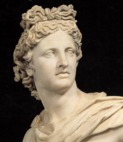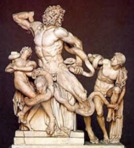
(pr. hel'le-nis"tek)
Many of the features of the Hellenistic style can be found in these works:
![]()

Discus
Thrower (Discobolus), Roman
copy of an original
bronze by Myron
 (Hellenistic
Greek, c. 485 - c. 425 BCE),
marble.
(Hellenistic
Greek, c. 485 - c. 425 BCE),
marble.
A second point of view of
the Discus Thrower. See
point of view.

Greek,
Apollo
Belvedere, c. 330 BCE,
marble, Vatican
 Museum.
Museum.
Detail: the head of the Apollo
Belvedere. See fig
leaf.

Apoxyomenos (Scraper),
Roman copy of an original
bronze by Lysippos, a Greek sculptor who worked c. 325
BCE,
marble, height
82 inches, Vatican. Apoxyomenos, a gymnast, is portrayed
scraping dusty oil from his right arm with a tool called a strigil.
Lysippos provided the foundation for Hellenistic sculpture.
The sculpture's fig leaf
was added later as censorship
in the interest of modesty.

Spinario (Thorn-puller), Roman bronze copy
of a Hellenistic original,
4th century BCE,
Museo Conservatori, Rome.

Laocoön
and his Sons, Roman copy
of a Hellenistic original
from c. 200 BCE,
marble, height
1.84 m, Vatican. Trojan priest Laocoön and his two sons
are attacked at an altar
by giant snakes. Pliny
said it was the work of three sculptors from Rhodes, Hagesandros,
Polydoros, and Athenodoros. The date of the Laocoon is
controversial, some scholars arguing for the late second century
BCE,
others for c. 50 BCE.
See pain and Roman art.

Greece, Statuette of a veiled and masked dancer,
3rd-2nd century BCE,
Hellenistic, bronze, height
8 1/16 inches (20.5 cm), Metropolitan Museum of Art, NY.
Hellenistic Greece, Samothrace (island in the North Aegean Sea), c. 190 BCE, Nike on the Prow of a Ship, called the "Winged Victory of Samothrace", gray Lartos marble for the ship's prow, white Paros marble for the statue, height 3.28 m (floor to top of wings) (10 feet 9 inches), Louvre. See Nike.

Greece, Statue of Eros sleeping, 3rd-2nd century
BCE,
Hellenistic, bronze, length 33
9/16 inches (85.24 cm), Metropolitan Museum of Art, NY.
Roman copy after a Hellenistic original from the 2nd century BCE, Sleeping Hermaphrodite, marble, length 169 cm, Louvre. Ovid told the story of Hermaphroditus in his Metamorphoses (IV, 285...): Hermaphroditus was the son of Mercury and Venus. When the boy was 15, he and the nymph Salmacis were so in love with one another, that they prayed they would never part. The gods then made them one, with a body both male and female. See androgyny.
Hellenistic Greece, Melos (the Cyclades islands), Aphrodite, known as Venus of Milo, c. 100 BCE, marble, height 6 feet 10 inches (2 m), Louvre. Signed on the base: "[Alex?]andros son of Menides from Antioch-on-the-Meander made it".
Hellenistic Greek, Antium (Italy), c. 100 BCE, Nude Male Combatant, called the "Borghese Gladiator", marble, height 157 cm, Louvre.
https://inform.quest/_art